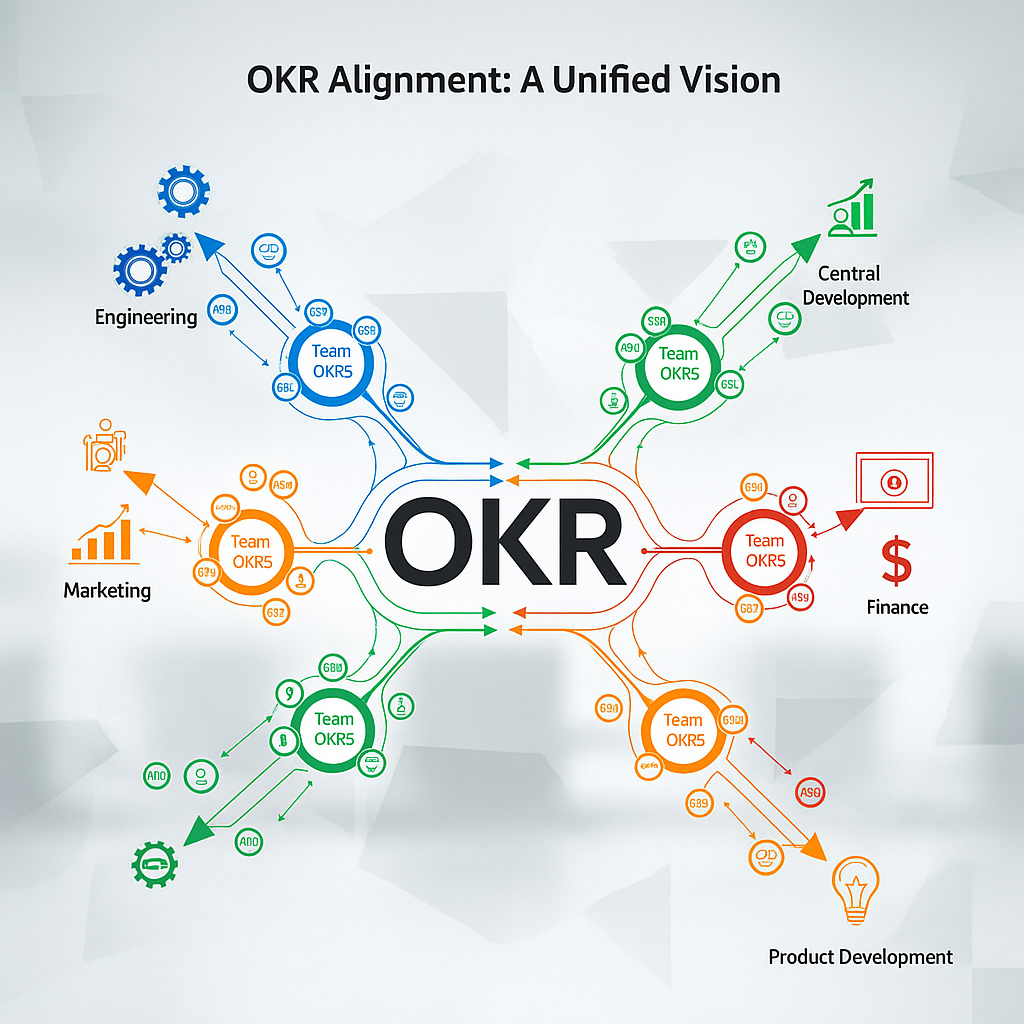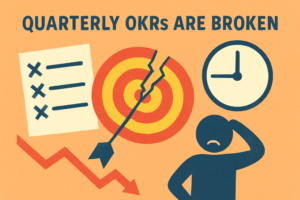I’ve watched too many companies get excited about OKRs, roll them out with great fanfare, and then wonder six months later why everyone seems more confused than before. The problem usually isn’t with OKRs themselves – nobody took the time to figure out how to make them work together across different teams.
You know the drill if you’ve ever worked in a matrix organization. You’re getting pulled in three different directions by three managers, each with their own priorities. Meanwhile, the product team is building features that marketing doesn’t know how to sell, and customer support is dealing with problems that engineering thinks they already fixed. Sound familiar?
This is precisely the mess that good OKR alignment can solve. But here’s the thing – most companies do it wrong.
Why Matrix Organizations Drive Everyone Crazy
Let me be blunt: matrix organizations are complex. They’re designed to be flexible and responsive, which sounds great in theory. In practice, it often means you’re reporting to multiple people who want different things from you.
I worked with one company where the sales team had quarterly revenue targets, the product team was focused on feature releases, and customer success was measured by retention. These were all good goals individually, but they were actively working against each other. Sales were promising features that didn’t exist, the product was building things customers didn’t want, and customer success was left cleaning up the mess.
This is precisely the kind of dysfunction McKinsey researchers have documented in their work on matrix organizations – without precise coordination mechanisms, the flexibility of matrix structures becomes a liability.
The root problem? No one was looking at the big picture. Each department was optimizing for their own metrics without considering how they connected to what the company needed to achieve.
What OKR Alignment Actually Means
Real OKR alignment isn’t about making every team’s goals look identical. It’s about making sure that when each team succeeds at their goals, the company moves forward as a whole.
Think of it like a relay race. Each runner has their own section to focus on, but the whole team loses if they’re not coordinated on the handoffs. Your marketing team might nail their lead generation targets, but if those leads aren’t the right fit for what sales is equipped to close, you haven’t really moved the needle.
There are three ways teams need to be aligned, and most companies only think about one of them:
Top-to-bottom alignment is what everyone focuses on. It’s making sure that individual goals support team goals, which support department goals, which support company goals. Pretty straightforward.
Side-to-side alignment is where things get interesting. This is about teams actually working together instead of just working in parallel. When the product team’s roadmap connects with marketing’s campaign calendar, horizontal alignment works.
Strategic alignment is the hardest one. This is making sure your quarterly goals actually serve your long-term strategy, not just whatever feels urgent right now.
The Right Way to Cascade OKRs
Most companies get cascading wrong. They think it’s about breaking big goals into smaller pieces and handing them out. That’s not cascading—that’s just delegation with fancy names.
Real cascading starts with context, not commands. Before anyone writes a single objective, everyone needs to understand not just what the company is trying to achieve, but why it matters and what success looks like.
I always tell teams to start their OKR planning sessions with this question: “If we nail our company objectives this quarter, what will be different about our business?” Get specific. Will customers be happier? Will our product be faster? Will we have more cash in the bank? Make it concrete.
Once everyone gets the “why,” then you can start talking about the “what.” But here’s the key – let teams figure out their own objectives. They know their domain better than you do. Your job is to make sure their objectives actually connect to the bigger picture.
This approach aligns with what Martin Fowler describes in his analysis of team OKRs – the most effective OKR implementations give teams ownership while maintaining strategic coherence.
A few practical rules I’ve learned:
Keep it to 3-5 objectives per team, max. I’ve never seen a team successfully juggle more than that. If you think you need more, you probably haven’t prioritized ruthlessly enough.
Make everything visible to everyone. I don’t mean just posting OKRs on a wiki that nobody reads. I mean creating real transparency where teams actually know what other teams are working on and why.
Build in regular check-ins, but don’t make them bureaucratic. A quick monthly “how are we doing and what’s in our way” conversation works better than elaborate progress reports.
The folks at Betterworks have documented this well in their research on maintaining OKR alignment – consistency matters more than complexity when it comes to tracking progress.
Making Collaboration Actually Happen
The magic happens when teams start to see their success as interconnected. I worked with one company where the engineering team realized that their code quality metrics directly impacted the customer support team’s response times. Once they made that connection, both teams started collaborating in ways that improved both sets of metrics.
But this doesn’t happen automatically. You have to create opportunities for teams to see these connections. Regular cross-team demos work well, as do shared post-mortems, where teams examine what went right and wrong across department lines.
If you’re looking for more specific strategies on building this kind of collaborative culture, I wrote about practical approaches in “The Art of Teamwork: Building a Collaborative Culture from the Ground Up.” The techniques there work especially well when combined with aligned OKRs.
A Real Example (Not a Perfect One)
Let me show you how this might work in practice. Say your company wants to improve customer satisfaction—a goal that requires multiple teams to succeed.
The company objective might be something like: “Reduce customer complaints by 40% while maintaining growth targets.”
The product team might own: “Eliminate the top three sources of customer frustration identified in support tickets.” Their key results could include shipping specific fixes and measuring the impact on support volume.
Customer support might own the slogan “Resolve customer issues faster and with higher quality.” They could measure response time and resolution rates and track themes in feedback to share with the product.
Marketing might own: “Set better expectations for new customers.” They could measure things like the accuracy of feature descriptions and customer satisfaction in the first 30 days.
Notice that each team clearly owns its part, but its success depends on the others’ success, too. The product needs support’s feedback to know what tot needs the fix, and suppor product’s fixes to resolve issues faster. Marketing needs accurate information from both teams to set the right expectations.
The Bottom Line
Good OKR alignment isn’t about creating perfect cascading charts that look impressive in presentations. It’s about getting teams to work together toward shared outcomes instead of just checking boxes on their own to-do lists.
Most companies overcomplicate this. They create elaborate frameworks, run workshops, and build fancys. But the core of it is simple: make sure everyone understands what matters, give them the autonomy to figure out how to contribute, and create enough transparency so that they can see how their work fits into the bigger picture.
If your OKRs create more meetings and confusion instead of more clarity and better results, you’re probably doing too much process and not enough actual alignment. Step back, simplify, and focus on the outcomes that matter.
Ready to stop treating OKRs like a checklist and start using them to align your teams? Join our upcoming workshop, where we’ll work through real examples from your organization – no theoretical frameworks, just practical strategies that work.
If you’re just getting started with OKRs and want a more detailed foundation, check out “OKR Implementation: Turn Goals into Results with FACTS.” For a complete implementation roadmap, check out our guide, “90-day OKR transformation roadmap,” on our resource page. It walks through exactly how to roll this out in your organization.




